|
- Japan - a very
special country indeed!
-
- click a picture to see details
|
|
|
Japan
is: very polite reception and particularly complicated car entry conditions The afternoon sun spreads a silver
glow on the sea, as we drive our Landcruiser out of the vessel "Figaro" at the
port of Kobe. We park the car on the berth and hop into a waiting taxi for completing the
immigration and customs papers. The immaculately dressed driver with white gloves bows
deeply and opens courteously the door to his car where white laces cover the seats. It is
a hearty reception in this special country about which we know so little. The complicated
and apparently very costly car entry conditions caused us more than headaches during the
last days of our sea journey - starting from the MOT inspection, the expensive adjustment
of the vehicle to the Japanese regulations and the inevitable shut-down of the car during
this time, up to the replacement of the Swiss license plates into Japanese ones. Will we
ever manage to enter the "Land of the Rising Sun"? Two hours later, although
without local Kobe license plates, we integrate into Japans left-hand traffic. Until today
we do not know whether these easy customs formalities were due only to lucky circumstances
or to the efficient preparatory work of the Japanese Wallenius agent. |
|
Japan
is: immensely hilly, wooded and subtropical landscape It is still rainy season and it pours
like in the Tropics when the day after our arrival in Kobe we cross by car ferry over to
the small island of Awaji-shima. Immediately, it becomes rural. Traditional timber houses,
well-maintained gardens with Bonsai trees and the fresh green of the rice fields decorate
the landscape. Small, narrow sandy beaches follow the winding single-lane island road
equipped with large mirrors. Tropical jungle vegetation with beautiful bamboo forests
grows exuberantly in the interior and curious monkeys roam on the roadside. Obviously, the
high numbers of mirrors put up along the roads are for the observation of the oncoming
traffic on blind curves. |
|
|
|
|
|
|
|
|
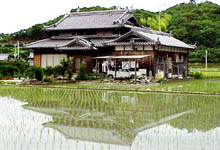 |
|
Japan
is: traditional exchange of gifts An old Japanese woman is heading with
a tricycle to her overgrown garden on the coastal road. Probably she has never seen such a
safari equipped vehicle on her tiny island before and obviously she would like to know
more about us. But unfortunately, she cannot speak English and we speak no Japanese. She
is very pleased however, when we present her with a flowering plant which was given to us
by an enthusiastic Landcruiser driver shortly before. Without hesitation she disappears
into her tiny garden and picks up a bouquet of colourful flowers for us. This gesture
touches us, but it belongs to the century old tradition of this country, where the
exchange of gifts always has been playing a large role. Also due to that special tradition
so many souvenir and gift shops are apparent around the islands. It is also custom to
bring along a gift to family members and even to the business colleagues left behind, how
ever short the trip might have been. It brightens the others that have been left behind
with their work and sorrows. |
|
Japan
is: rural enchantment and magnificent gardens |
|
|
|
|
|
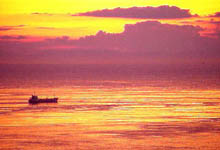 |
We are
approaching Alma, an agricultural corner. Large racks out of timber with brown onion
bundles hung up are scattered around the freshly planted rice fields and are reflected in
the calm water. A woman rice farmer covered with a large straw hat is working on her field
in front of her traditional house. We are totally fascinated by the beauty and calmness of
this place. |
|
|
|
|
|
|
|
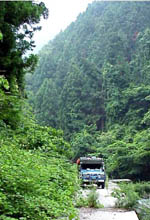 |
|
Just as
the setting sun changes the blue skies and the calm Inland Sea into strong red colours, we
reach the impressive Naruto-Kaikyo Bridge which leads to the next island Shikoku. Here, we
spend the night between the vast ocean and a greenish lake, surrounded with reed plants.
Black-and-white dragonflies perform an evening dance and frogs croak in chorus, before
complete darkness surrounds the sound and us ceases. |
|
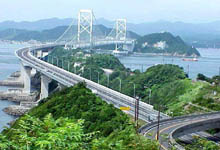 |
|
Next
morning, we cross the modern, impressive bridge and leave the densely populated valley of
the Yoshino-gawa Rivers behind us. |
|
We follow
the lonely road pass with flowering plants towards Takamatsu. Up to 3000 feet height,
small villages nestle on steep slopes, where beans and tea are growing magnificently. It
starts to rain again, as we reach Takamatsu and park in front of the beautiful Ritsurin
Park, which formerly belonged to the summer villa of the Matsudaira family. This artfully
landscaped garden includes bizarrely shaped trees, fruit orchards, Lotus flower gardens,
small lakes, groups of rocks and the forested Mount Shiun. |
|
Japan
is: wild, deep gorges and Hot Springs The heavy rainfalls of the last days
caused immense landslides in the steep slopes near Ikeda. Extensive cleaning up work is
under way everywhere. As we reach the turn off to the Iya-kei Gorge, we hesitate. What is
written on that big sign? No entry? Everybody we ask, their answer consists of shaking
heads. Nobody understands us. One points to the watch, another to the nose (Later we find
out that the watch means hourly traffic — the meaning of pointing to the nose we
never found out). Nobody stops us to drive through the untamed, tropical vegetation along
this fantastic gorge. Deep below us, the brown waters of the flooded river make their way
in many turns through the impenetrable forest. Everywhere waterfalls foam through steep
slopes and debris and rocks of the recent violent tempest cover the road. At one of the
many hot springs the road is blocked by high rubble, large trunks and a new born
waterfall. We decide to turn back. |
|
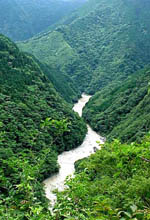 |
|
Japan
is: bizarre coastal regions and nostalgic fishing villages |
|
|
|
|
|
|
|
|
The first
sunbeams shine through a dark cloudy sky, as we follow the coast to Cape Ashizuri-misaki.
We pass Ohki Beach at Tosashimizu, which contrasts like an endless yellow half moon
against the deep-blue sea. From the strange shaped rock formations stacking out of the
sea, we can only get a glance now and then, when the deep jungle thins out. But the
beautiful Kongofuku-ji temple at the far end makes up for the small disappointment. Later,
we spend the night at the lovely gravel bay of Tatsukushi between polished reddish
sandstone rocks, orange coloured wild lilies and dense bamboo bush and we feel happy. We
watch two large birds of prey sitting on a branch, fixing their eyes on the catch of a
solitary fisherman. We enjoy the multicoloured butterflies circling around a shallow water
pool and listen to the noisy chirping of the crickets. |
|
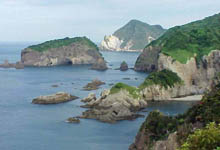 |
|
The
western coastal strip of the island is very traditional. We enjoy the mixture of the faded
fishing boats, colourful buoys and crates piling up in front of the simple houses of the
fishermen. Hundreds of black and white buoys and floating bamboo rafts decorate huge parts
of the protected bays. They are a great sight and show that the Japanese have a close
relation with their surrounding sea. |
|
Japan
is: Sex museums with exhibition of sex customs of different races Our final destination in Shikoku is
the Taga-jinja Shrine in Uwajima - a rather unusual museum. There, an oversized penis
carved from a tree trunk decorates the entry to the three-storey sex museum — a
remnant of earlier times, where many Shinto Shrines had a connection to fertility rituals.
Sculptures of many sizes, fading photographs and tools of sex customs of different groups
are shown in a great disorder in glass showcases from the bottom to the top. Particularly
amazing are the tiny temples where doors open to a phallus. After seeing all the phallic
sculptures, we drive the last miles to the westernmost tip of this Island, to Cape Misaki. |
|
Japan
is: extremely high transport and living costs An old ferry transports us from the
harbour of Misaki in one hour to the southern island of Kyushu. We calculate that we have
to pay for this short passage US$ 1.10 per minute. The outrageous costs of the motorways
of $ 0.35 per mile are out of bound too - a fact that makes us decide later to drop the
visit of the northern Island of Hokkaido. Also the cost of many toll roads to scenic
places add up considerably, charging up to $ 10 just before reaching the tourist
destination. Fortunately, we could keep low the costs of living, as we stocked-up our
Landcruiser in Dubai with inexpensive food. Thanks to the low crime rate in this country,
it was possible - except in Tokyo — to camp in the wild and sleep in our Landcruiser,
thus saving the extremely costly expenses of accommodation. |
|
|
|
|
|
|
|
|
|
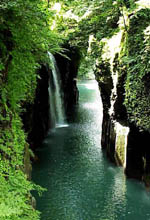 |
|
Japan
is: active volcanoes We drive the toll road to the gigantic
volcanic area of Mt. Aso, one of the largest of the world. An extraordinary sight is the
lush green, perfectly formed cone of Mount Komezuka (translated as rice mound). It
surrounds, together with four other recently formed volcanoes, the fertile planes and
small villages of the large caldera, 15 miles in diameter. Mist rises from the valley up
to these 3000 feet height. It bubbles between the volcanic cones and the smell of sulphur
from the close caldera penetrates into our noses. Here, we spend a wonderfully cool and
calm night, before we decide to head down into the scorching heat of the plains again and
visit the beautiful gorge of Takachiho, which is surrounded by many myths and reveals
lovely waterfalls, overhanging, moss-covered stones, giant ferns, sheer walls and narrow
passages. It is a wonderful place to enjoy, until large noisy tour groups arrive with
their megaphones and destroy the magic moments. |
|
|
Japan
is: a wide system of artificial lakes, white sandy beaches and beautiful shrines |
|
|
|
|
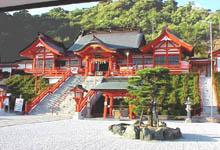 |
It
becomes increasingly deserted and wild, as we drive for hours through a lonely rugged
mountain road with steep gorges and artificial lakes from Shiiba to Saito. Often, the
single-lane road becomes so narrow and dark from the advancing jungle that we fear getting
stuck at any moment. The
next day, we are again in populated areas, as we drive towards Cape Toi, the southernmost
point of the main islands of Japan. White sandy beaches alternate with bizarre pinnacles
rising up out of the sea, flowers bloom on the banks, first palms emerge. The main
attraction of this coastal region is the wonderfully orange coloured Udo-jingu Shrine in a
superb setting. |
|
|
|
|
|
|
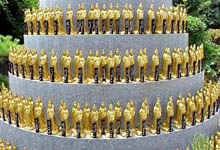 |
|
We enter
the small mystic cave through richly carved arches and are overwhelmed by the beauty of
the main temple in red and gold, which looks like a precious treasure box. This
outstanding sight is one of those unforgettable moments one would like to keep in memory
forever. Later,
towards Kagoshima with its impressive Sakurajima volcano, the densely overpopulated areas
increase more and more. So we decide to forgo the cultivated West Coast of Kyushu and take
the expensive motorway back to the main island of Honshu. |
|
|
Japan
is: place of first atomic bomb in Hiroshima On that dark morning we are filled
with a flood of emotions as we enter the Peace Memorial Park in Hiroshima. It was August
6, 1945, 8.15 a.m., at the start of normal daily activities, that the first atomic bomb
exploded approx. 2000 feet above this lovely town with its many bridges. The consequences
of the incredible explosion were tremendous: 75’000 people were killed immediately
and by the end of December 85’000 humans died from radiation exposure burns. The
death toll has probably now reached 200’000 as people continued to die from the
radiation. The impressive, three-storey Peace Memorial Museum shows the tragedy in
dramatic films, models, family scenes and descriptions. |
|
|
|
|
|
|
|
|
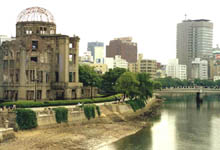 |
|
20’000
tons of TNT was the power of the Atomic Bomb, which flattened all buildings in a diameter
of two and half miles from the epicentre. The ruins of the dome of the Chamber of Industry
and Commerce at the bank of the river Motoyasu-gawa are a symbol of destruction. Its
burned out dome is visible through the arch of the Monument to the Victims. No one of the
many visitors leaves this dramatic place untouched. Their agitated faces reflect their
deep feelings. |
|
Japan
is: cosy restaurants and perfectly organised service of tourist masses |
|
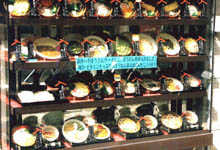 |
We
proceed to Osaka. Once more we are driving through never ending cities and heavily
congested roads. The nice reception by our friendly Swiss consul and his invitation to a
Japanese lunch in the heart of the downtown make our spirits rise again. We find ourselves
in a cosy, miniature place with space for only about a dozen of guests sitting around a
counter with a hot iron plate in the middle and are greeted with a hearty welcome.
Immediately, a cup of tea is served, followed by a hot towel for wiping our face and
hands. Out of the long list of delicious food, we chose the days’ menu and we are
first served soup, a bowl of rice, salad and soy sauce on a tray. Meanwhile the chef
prepares spicy pieces of beef, mushrooms, pumpkins and bamboo roots on the hot iron plate
in front of us. It tastes delicious. |
|
After a
few days in busy Osaka, where we tried unsuccessfully to get a Russian visa for the
planned continuation of our journey through Siberia, Mongolia and further to the Caucasus,
we head Northeast to the tree-lined sandy landspit of Ama-no-hashidate. According to our
guidebook it is one of the three most scenic places in Japan. One tourist bus after the
other arrives and releases hordes of people. We watch them walk straight away to the first
floor of a souvenir shop, where on a long table rows of colourful bowls with food are
already waiting for them. Everything is perfectly organised: Before they sit down on soft
cushions around the table, they get a blue plastic bag for their shoes to be taken off.
The next moment, they are eating with their traditional wooden chopsticks, which are
always used only once and then discharged. Only thanks to this systematic, thoroughly
organisation is it possible to serve such an unbelievable crowd of people in the shortest
period of time. |
|
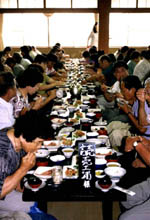 |
|
Japan
is: where the customer is (still) the king |
|
|
|
|
|
|
Next
morning we stop at a supermarket just as the doors open, right in time to take part at the
refreshing, traditional reception of the customers. With the sounds of music as
background, the employees stand parade on both sides of the entry and greet everyone with
an enchanting smile and polite bows — it is a tradition that makes us feel so
welcome. |
|
Japan
is: large fishing fleets and preference of fresh fish |
|
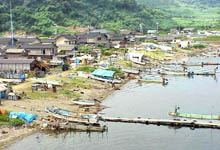 |
It is a
cloudy Sunday morning as we approach the rugged Echizen West Coast. Diving schools, crab
and fish restaurants and shops spread all over. The diversity of fresh fish displayed is
incredible. There is everything available the sea is offering and the heart desiring, from
sea bream, shrimps, salmon, squid, shells, seaweed to expensive giant crabs which cost
around US$50 a piece and leave the shop neatly packed in white polystyrene boxes. |
|
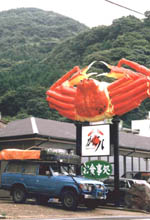 |
|
Money
obviously is not a big issue. More important is that the fish is fresh, preferably still
wiggling. Looking at the wealth of seafood and the numerous fishing fleets laying in the
picturesque harbours, we automatically ask ourselves how long the sea will be able to
provide this enormous daily demand of fresh fish. |
|
|
Japan
is: sense of comfort and beauty A very special experience is the visit
to a restaurant wash room on this rocky coastal strip. Each toilet is placed in the middle
of an individually landscaped exotic garden with Bonsai trees, flowers and attractively
carved stone monuments. Water is running through bamboo sticks into a tiny fountain, the
sound of singing birds fills the air — a perfect feeling of being out in nature.
There, where no real water is murmuring, a button can be pushed and this noise can be
heard over loudspeakers. |
|
Japan
is: mystic Mount Fujisan and deep blue crater lakes As we get closer to the region of the
five Fuji lakes, a concentration of clouds surround the dormant volcano and makes its
appearance change continuously — once a dark cap surrounds it, then a white circle.
From our isolated camping spot we admire in the darkness the lights of the mountain path
leading to the volcano that attracts approximately 3000 visitors every day in the two
months of its climbing season. Nowadays, there is not much wilderness remaining, as on
each stop there are the popular beverage dispensers, which can be found for the well being
of the people on every corner in all Japan. Of course, on the top there is the convenience
of a telephone to let the relatives know about the arrival on the summit, and the
inevitable gift shop is open. |
|
|
|
|
|
|
|
|
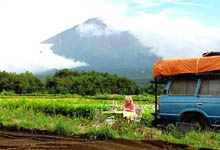 |
|
We feel
absolutely no desire to join these crowds and prefer to look at this magnificent mountain
from always changing new viewpoints. This region on Tokyo’s doorsteps becomes our
favourite place when we want to escape the scorching heat of the capital filled with the
waste heat of its uncountable airconditioners. |
|
Japan
is: extreme densely populated coastal regions, 40 millions inhabitants in Tokyo’s
suburbs |
|
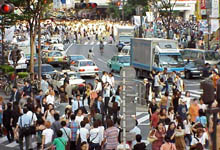 |
An acute
lack of space is the main problem of Japans 125 million people. No new car can be
registered without the proof of a parking lot. At home probably a room has to be
sacrificed. The short-term solutions for parking in cities are rotating platforms in
high-rise buildings, working like elevators! Multi-storey roads have been built as an
attempt to absorb the dense traffic, and luxury underground malls are available for
shopping. |
|
|
|
|
|
|
|
|
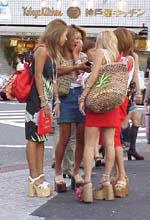 |
|
We are
allowed to park and sleep in our Landcruiser in the parking lot of the residence of the
Swiss embassy’s employees, right in the heart of the lively quarter of Shibuya.
During nine wonderful days, this exciting town with its 12 millions downtown-inhabitants
becomes a fascinating, unforgettable experience. We travel at any times of day with the
efficiently functioning underground and rapid trains, which carry in three-minute
intervals daily two millions extremely disciplined commuters in the area of Shibuya. We
spend hours watching the people waiting for the pedestrian light to become green and then
invade the animated streets like an army of busy ants. |
|
|
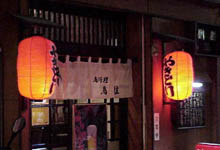 |
|
|
We get
never tired of admiring the flood of neon tubes and gleaming red lanterns in the evenings,
which transform the streets into a colourful festival of lights. We watch women, dressed
in traditional bright silky kimonos, mingle gracefully with correctly outfitted business
men in coat, jacket and tie and the youth scene in their fashionable look - in mini
skirts, striking make-ups and red or white tinted hair, stalking on eight inch high-heeled
cork shoes. |
|
Japan
is: quiet oasis of National Parks with outstanding nature and sensuous shrines |
|
|
Not far
from the hectic capital Tokyo lies the large temple and shrine complex of Nikko,
surrounded by green forest walls. 15000 artisans from all over Japan contributed to this
unique architectural masterpiece. We admire all gold splendour, woodcarvings and
paintings, the richly decorated arches, shrines, bell and drum towers and the five-storey
pagoda. Only when the many school children start to invade the quite place and get on our
nerves do we flee to the quietude of the nearby Yumoto and Chuzenji Lakes within the Nikko
National Park. As we are driving through the great natural beauty of the Ginzan Lake, we
adventure for the last time our feeling of happiness in such beautiful surroundings. We
adventure also for the last time our miserable time in violent rainstorms, as we visit the
mountains in Hakuba near Nagano. Right were the 1998 Olympic Games took place, we pass on
August 17, 1999 the 500´000th kilometre of our journey around the world. |
|
|
|
|
|
|
|
|
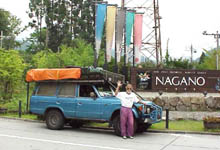 |
|
Japan
is: safe world and its attempt to preserve it On September 9, 1999 our last day in
Japan has approached. We say good-bye to Nippon, to a country, where we always felt
comfortable and safe. But we say good-by also to a world which in their way of living and
thinking is so different from ours, where due to language difficulties we were not able to
communicate with people — with the taxidriver, who opened us politely the doors, the
modest farmer on the foot of Mount Fuji, the young lady in the silky kimono in Hachido or
the correctly dressed business man in a suit and tie, who showed us the right way. They
all contribute to the fact that this special Asian country will remain in our thoughts and
hearts as a very special country.
As Mandarin Airlines takes
off to its flight via Taiwan to Vancouver in Canada, we are also on board. Our faithful
Landcruiser is already sailing with the vessel ´Bright Stream´ of the Japanese Eastern
Car Liner on free transport towards its new destination. |
|
-
- More pictures from Japan
|